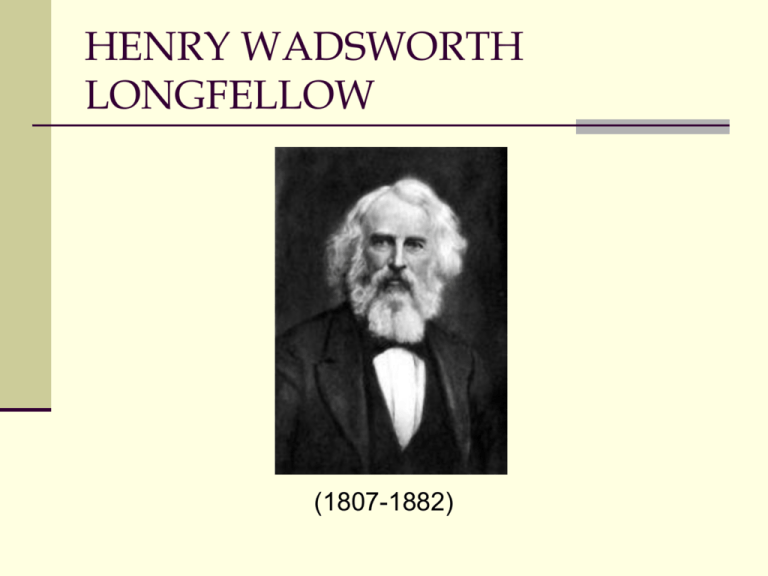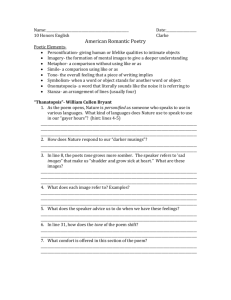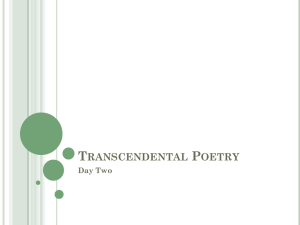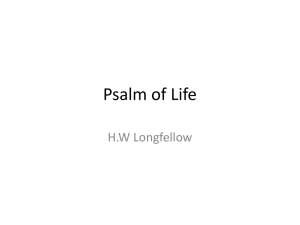HENRY WADSWORTH LONGFELLOW
advertisement

HENRY WADSWORTH LONGFELLOW (1807-1882) List of Longfellow's Works Evangeline: A Tale of Acadie (Epic Poem) (1847) The Song of Hiawatha (Epic Poem) (1855) Major Themes, Historical Perspectives, and Personal Issues Longfellow's themes in the poems in this collection are nearly indistinguishable from those of his contemporaries in England. It's useful to show him, therefore, as an example of the branch of American literature that created itself in admiring imitation of English literature. He is also that rare thing, a genuine celebrity of a poet, whose fame has subsided and whose stature has shrunk accordingly. Many of the poems we now admire most are from his later years, and conform better to modern taste than the poems for which he was famous in his lifetime. Thus, he can be used as a good example of the ways in which changing literary tastes alter literary reputations. Significant Form, Style, or Artistic Conventions Longfellow's poems are not only accessible in their meaning, but they are also highly regular in their form. It is very simple to teach metrics with Longfellow because he provides easy and memorable examples of so many metrical schemes. These can be presented in connection with Longfellow's personal history, for he is of course an academic poet, and as such a poet writing often self-consciously from a learned perspective. Thus, nothing with him seems wholly spontaneous or accidental. “The Song of Hiawatha” Critical Analysis While The Song of Hiawatha was roundly praised on both sides of the Atlantic after its publication, criticism in more recent years has been considerably less laudatory. Longfellow's choice to mimic the solemn, unrhymed tetrameter of the Finns’ Kalevala has caused his poem to be criticized by many, to the extent that some have felt Longfellow plagiarized the Finnish work. While the poem was sometimes mocked by his contemporaries, it has been subjected to increasing satire through the years, even being lampooned in Marx Brothers films and Bugs Bunny cartoons. Critics have also debated what sources Longfellow used, and some have been annoyed by the anachronism of the arrival of white men when Hiawatha's stories are more properly set long before the European settlers arrived. Nevertheless Longfellow’s poem was popular with the public. Despite the flaws critics have highlighted in the work, The Song of Hiawatha is still widely accepted as a significant nineteenth-century American poem. “A Psalm of Life” Critical Analysis Longfellow once said that if a poet “wishes the world to listen and be edified, he will do well to choose a language that is generally understood.” Early critics of “A Psalm of Life” appreciated what they saw as the simple beauty of Longfellow’s language. One early reviewer wrote in The North American Review in 1840 that Longfellow’s poems “are filled with solemn pathos, uttered in the most melodious and picturesque language.... [How] rare is it to find poetry to compare with [‘A Psalm of Life’].” Another critic, writing in The Christian Examiner, stated that “A Psalm of Life” “is equally admirable for its simplicity, manly fervor, dignity, and truth.” But not all of Longfellow’s contemporaries valued his high moral tone and his didacticism — his obvious efforts to teach moral truths. Edgar Allan Poe, for instance, writing in Graham’s Magazine, condemned Longfellow for making “didacticism ... the prevalent tone of his song.” Poe’s complaint was not with Longfellow’s moral lesson, as such, but with Longfellow’s method of driving home that lesson: “We do not mean to say that a didactic moral may not be well made the undercurrent of a poetical thesis, but that it can never be well put so obtrusively ....” Twentieth-century critics have tended to agree with Poe’s assessment that “A Psalm of Life” is overly didactic. Indeed, the word “didactic” surfaces repeatedly in twentieth-century criticism of the poem. Howard Mumford Jones, in an essay titled “Longfellow,” characterized “A Psalm of Life” as an “obvious and awful didactic piece,” though he did appreciate the poem’s “admirable” fourth stanza. And another critic, Alfred Kreymborg, in Our Singing Strengths: An Outline of American Poetry, caustically described “A Psalm of Life” as “nine jingling verses, dripping with a larger number of clichés than any other poem in the language.” Perhaps because of the poem’s obvious moral tone, by the middle of the twentieth century, critics had largely stopped writing about it. Still, in 1993, Dana Gioia, writing in The Columbia History of American Poetry, noted the longevity or continuing fame of “A Psalm of Life”: “This menacingly upbeat poem refuses to die.” Gioia argues that “A Psalm of Life” has remained in favor with popular (as opposed to scholarly) audiences precisely because of its obvious moral lessons. Gioia suggests, moreover, that the very clichés that Kreymborg so disliked are exactly what draw readers to the poem. While preachy clichés or proverbs might not make for good poetry, Gioia reasons, they have tremendous popular appeal: “‘A Psalm of Life’ fails as lyric poetry,” Gioia states, “because it belongs to a different genre, inspirational didactic verse.”






